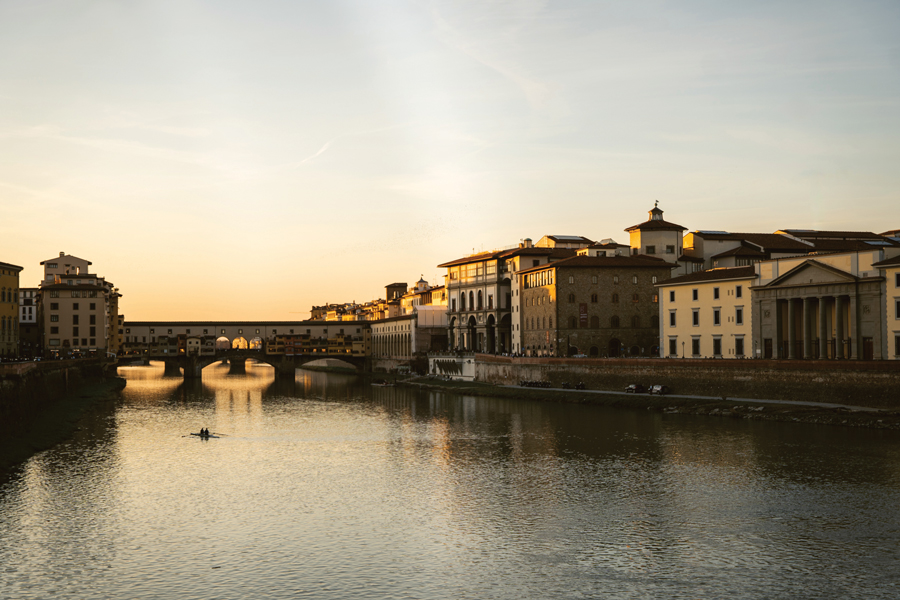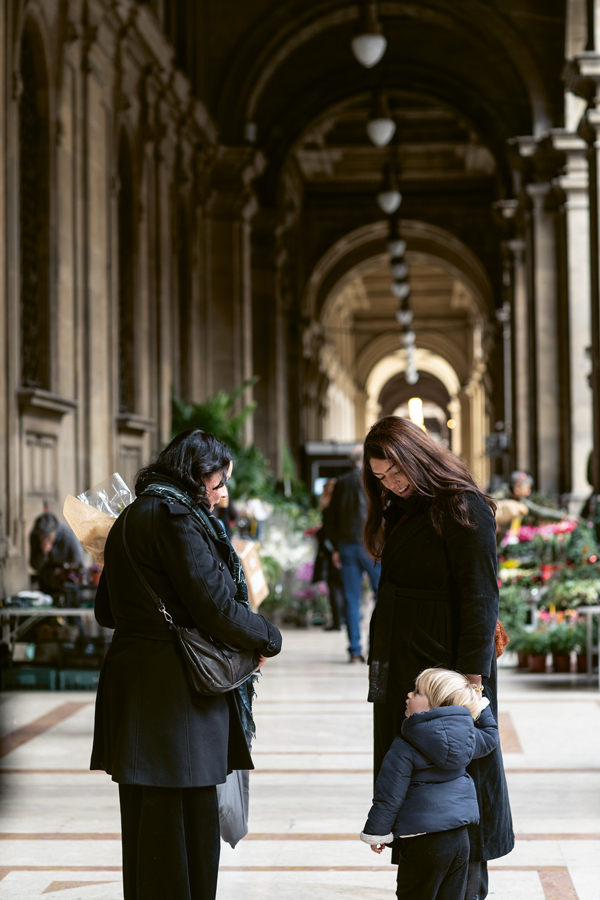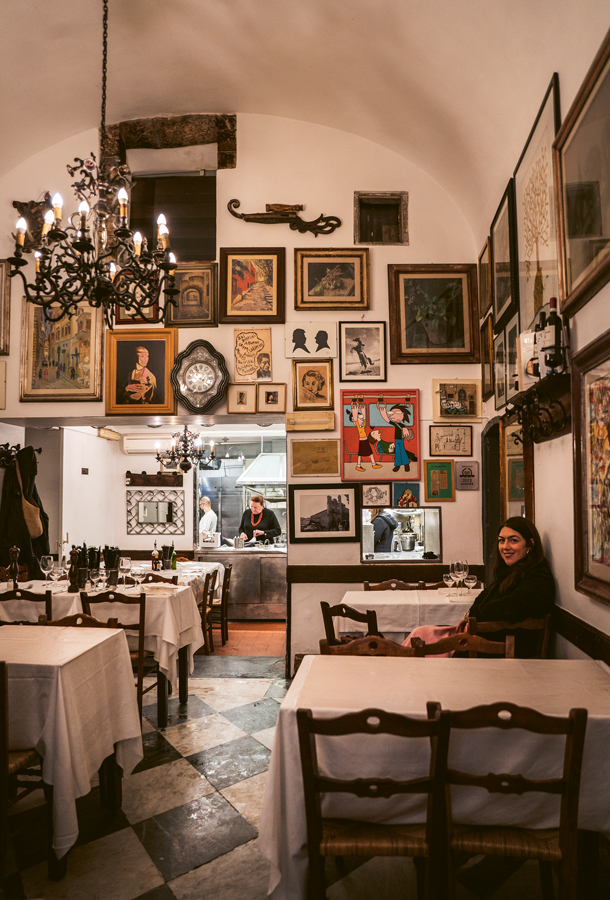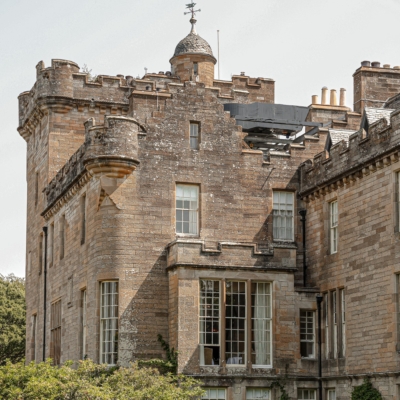The treasures of Florence are best explored in the colder months …
When I think of Florence, it is of the cacophony of church bells that accompanies my morning coffee every day at 8.30am sharp. The flat where I live with my husband Matthew and son Milo is in the city centre, across the road from the River Arno, on the top floor of an old palazzo. It snakes around an internal courtyard, meaning there are windows everywhere, with light pouring in and the sound of church bells from every corner. This makes up for the hike up the hundred stairs from the street (there’s no lift). Our road is narrow and busy, with the Ponte Vecchio at one end and the even more beautiful Ponte Santa Trinita at the other.

Santa Maria del Fiore seen from Via dello Studio.
The best time to step out is early in the morning before the tourists have had their breakfast. This is when you see a city lived in, with locals drinking their coffees at the bar, shopping at the market stalls in Piazza Santo Spirito and generally going about their errands. Early is also the time to visit the many treasures of Florence – if you brave the Uffizi Galleries in busier months, I would not consider walking through the doors more than two minutes after opening at 8.15am.

In front of the central door of the façade into Santa Maria Novella.
Winter is a moment of respite in this, one of the most visited cities in the world. It’s when I like to remind myself of the many treasures I live among, and will nip into a gallery or museum on the way to lunch to see a painting or fresco. Visiting churches is particularly rewarding in Florence as they house some of the city’s most beautiful objects. At either end of the Piazza Pitti are two such churches. The Chiesa di San Felice, at the south end, contains a wonderful fresco of San Felice reviving San Massimo, started by Giovanni da San Giovanni and finished by Volterrano in 1636, with a fabulous wintry landscape in the background. To the north, sandwiched between the Piazza Pitti and the Ponte Vecchio, is Santa Felicita, home to Pontormo’s Deposition from the Cross, an exquisite painting well worth a visit, especially if you come furnished with a one-euro coin to put in the meter, which then resplendently illuminates the altarpiece. I often prefer these little bursts of beauty in situ rather than the overwhelming cacophony of visual stimulation offered by wonderful museums such as the Uffizi.

Meeting our friend Betty at the flower market in Piazza della Repubblica.
When I do visit the more well-known sites, it tends to be in winter: from November to March, the city becomes quieter, allowing you to wander through churches such as San Marco, Santa Croce or Santa Maria Novella in relative quietude.
Winter or not, early morning is the only time to visit famous places like Rivoire, the glamorous bar on Piazza Signoria where you can get everything from coffee, pastries and intricate chocolates to cocktails, all served to you by white-coated waiters. At 8am you will find yourself surrounded by Florentines, usually loudly exchanging their recipes for lampredotto (stewed tripe) while the barmen make their coffee. Legend has it that Rivoire is the birthplace of the negroni cocktail, and they do still make the best; its colour is a pale muted red rather than the vivid vermillion of most negronis whose makers are too heavyhanded on the Campari.

Walking out of my favourite spot for coffee on Via de’ Bardi.
While I love nipping into Rivoire on a Thursday morning when I visit the weekly flower market in the covered gallery running off Piazza della Repubblica, my usual haunt for my morning coffee is a tiny, narrow little place called Caffe Melloni on Via de’ Bardi. It is family run and very friendly, with a whole little world going on each morning. There are no tables, just a couple of bar stools, so it is very much geared towards locals looking for a quick breakfast on their feet. When we first moved to Florence, the barman was a famously grumpy old Florentine who made a mean coffee and sang very loudly as he worked; he has since retired and the staff behind the bar are now entirely female, with the owners’ daughters having taken over.

This is what tends to make a good Florentine bar or restaurant – that many of them are still family run, making them lively and fun. These are the places I like to seek out, where the owners’ deep involvement means there is a strong pride in the food they are making and how they serve it. The longest-running and most successful are those that are unapologetically unbending to the fads of globalisation and tourism. Caffe Melloni, for instance, still closes every day for the family to have lunch from 1pm to 2pm, an hour when you might think a passing customer might like a sandwich themselves.

Lunch at Trattoria Cammillo.
Fabulous restaurants such as Alla Vecchia Bettola on the south side of the city, famous for their penne alla Vecchia Bettola (tomato and vodka pasta), were founded in response to the standardisation of “Italian food” in the 1970s. Rebelling against tourists arriving and asking for pizza or spaghetti with meatballs in a city famous for its grilled and roasted meats, vegetables and beans, Florentine trattorias such as the Vecchia Bettola decided to specifically celebrate Tuscan and Florentine dishes: crostini neri (Crostini with chicken liver pâté), coniglio fritto con carciofi (fried rabbit and artichokes), arista di maiale (roast herbinfused pork loin), bistecca alla Fiorentina (Florentine steak) and fagioli al fiasco (cannellini beans in olive oil). Still today, their food is hardy, tasty and happy-making. Andrea, the proprietor of another wonderful family-run trattoria – Casalinga, by Piazza Santo Spirito – tells me he would rather leave spaghetti carbonara to his colleagues in Rome, saying “What has carbonara got to do with Florentine food?”

Enjoying aperitivo with a view over Ponte Vecchio.
I have always spent time in Florence, as it was only an hour and a half’s drive from our home south of Siena, and being the capital of Tuscany was the nearest “big city” (or whatever you call a town with a population under half a million). Sometimes, to my great chagrin, I would be dragged around the antiques shops and markets while my mum hunted for treasures for her store in our local village of Buonconvento. On any such morning, she would cleverly make my sister and me think that it was our idea to go to Florence for an ice cream and a glamorous lunch. But soon we would be groaning with boredom and dragging our feet as we sat in yet another bric-a-brac shop while our mother negotiated heatedly with the proprietor as to the value of an old brass bed or painted cabinet. While these memories are vivid, it was as an adult that I really came to know Florence, when my husband and I moved to the city in 2016, ostensibly for a few months. We told our landlady that we’d need the flat for a year at most – yet here we still are, nine years on.

From Winter in Tuscany: Cosy Recipes and the Quanto Basta Way by Amber Guinness (Thames & Hudson) is out now.
SEE MORE: Fancy A Food-Focused Break?











